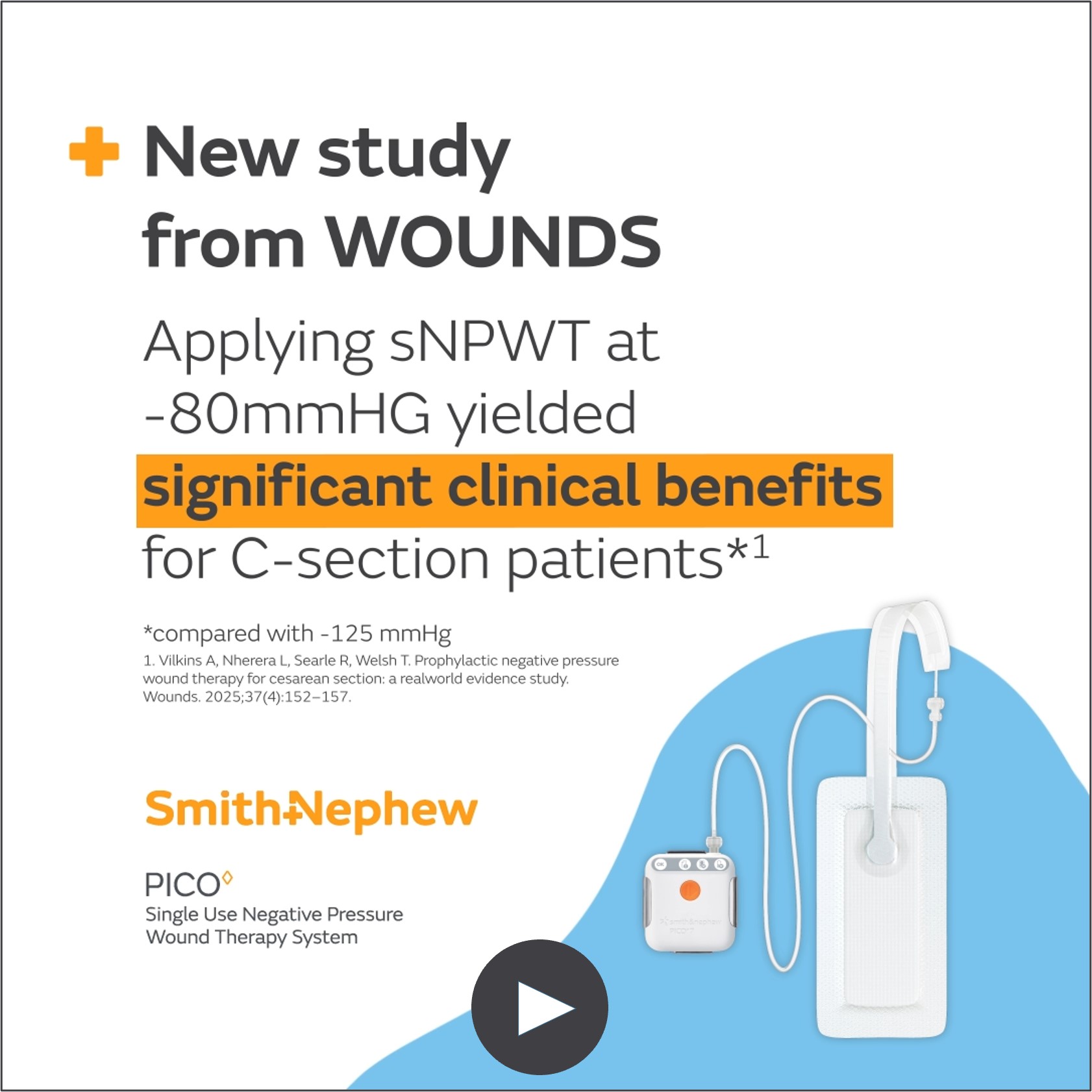A comparative sNPWT study of 10,000+ C-sections shows PICO™ sNPWT reduces complications
A comparative sNPWT study of 10,000+ C-sections shows PICO™ sNPWT reduces complications and cuts healthcare costs by $728,000 per 1,000 patients
Smith+Nephew (LSE:SN, NYSE:SNN), the global medical technology company, today announces findings from a newly published comparative study of single-use Negative Pressure Wound Therapy (sNPWT) devices in Caesarean section (C-section) recovery has identified significant benefits for postpartum use of Smith+Nephew's leading PICO sNPWT technology. Analyzing real-world data from over 10,000 C-section patients treated at different pressure levels, the study published in WOUNDS (April 2025) reveals that PICO sNPWT contributes to a significant reduction in surgical site complications (SSCs), including a reduction in the incidence of surgical site infections (SSIs), wound dehiscence and seroma, and overall costs, compared to another sNPWT device (P≤0.05).1
New survey: The real-life burden of C-section complications
A complementary survey of new mothers who have undergone C-sections highlighted the impact of SSCs on both mother and baby:2
- Mothers with complications reported requiring hospital readmissions
- Are 5 times more likely to describe their recovery as traumatic
- Over half (55%) reported feeling depressed than those that reported no complications
- Are 5.4 times more likely to be unable to breastfeed
- Two in three mothers (66.3%) reported that their overall c-section recovery impacted their ability to bond with their baby
Dr. Tia Welsh, M.D. Chair of Obstetrics and Gynecology at Valley Medical Group and co-author of the study added, “Postpartum is already a very vulnerable period for mothers, even without complications. SSCs add physical pain, prolonged recoveries, emotional distress, and disrupt critical early bonding with newborns. These interruptions carry emotional and practical burdens, increasing the risks of postpartum depression, anxiety, and trauma – costs that can't be captured in dollars alone.”
Real-world data shows the clinical and economic benefits of using PICO sNPWT in patients undergoing C-section procedures
The study used real-world evidence from the Premier PINC AI™ Healthcare Database to analyze outcomes from a geographically diverse mix of community hospitals, teaching hospitals and healthcare systems across the US.
Notable findings include significant reductions with PICO sNPWT, compared to other sNPWT devices in the incidence of*:
- Overall SSIs (p=0.018)
- Superficial SSIs (p=0.017)
- Wound dehiscence (p=0.005)
- Seroma formation(p=0.050)
“We've long understood the benefits of NPWT in surgical recovery, but this is the first large-scale study to directly compare different pressure levels in a real-world setting,” said Dr. Annmarie Vilkins, DO. Director of Obstetrics and Gynaecology at Henry Ford Health, and the study's lead author.“We found that PICO sNPWT showed significantly improved outcomes through optimizing pressure, fluid management, and skin adhesion. Its unique design helped maintain a high moisture vapor transmission rate supporting an ideal healing environment for recovery, particularly critical for high-risk incisions like C-sections under skin folds, where moisture buildup can lead to infection.”
PICO sNPWT is proven to reduce the odds of surgical site infections (SSIs)3, which could facilitate early mother and baby bonding and positively impacts on the patient's emotional wellbeing.4
Substantial cost savings with PICO sNPWT
Beyond clinical and patient benefits, the study highlighted substantial cost savings associated with PICO sNPWT, estimating a reduction of US $728,220 per 1,000 patients and 3.8% lower mean index admission costs compared to other sNPWT devices (p<0.001).1
“SSIs alone are associated with costs exceeding US $900 million annually5. This latest data shows that NPWT may help improve clinical outcomes, reduce costly readmissions, improve resource efficiency and provide better post-surgical care for the significant number of new mothers who undergo C-section deliveries.” commented Rohit Kashyap, President of Advanced Wound Management, Smith+Nephew.
High-risk C-section births require improved post-surgical care
C-sections account for around 32% of all US births6, yet carry a 5-to 20-times higher risk of maternal morbidity than vaginal births.7 Post-surgical complication risk is significantly increased by factors such as obesity, diabetes, smoking, and hypertension, with 44.6% of U.S C-sections considered high risk.8 Obesity alone is associated with a two-to seven-fold higher risk of developing SSIs compared to individuals with lower BMIs.9,10,11
Complications related to C-sections can lead to increased maternal mortality12, prolonged hospital stays and elevated healthcare costs13, while also impacting a mother's ability to bond with her newborn.14 Despite this, the Center of Disease Control (CDC) estimates that over 80% of maternal mortalities are preventable.12
For more information, please visit: https://www.possiblewithpico.com/pico-obgyn
-ends-
Enquiries
Dave Snyder +1 (978) 749-1440
Smith+Nephew david.snyder@smith-nephew.com
About Smith+Nephew
Smith+Nephew is a portfolio medical technology company focused on the repair, regeneration and replacement of soft and hard tissue. We exist to restore people's bodies and their self-belief by using technology to take the limits off living. We call this purpose ‘Life Unlimited'. Our 17,000 employees deliver this mission every day, making a difference to patients' lives through the excellence of our product portfolio, and the invention and application of new technologies across our three global business units of Orthopaedics, Sports Medicine & ENT and Advanced Wound Management.
Founded in Hull, UK, in 1856, we now operate in around 100 countries, and generated annual sales of $5.8 billion in 2024. Smith+Nephew is a constituent of the FTSE100 (LSE:SN, NYSE:SNN). The terms ‘Group' and ‘Smith+Nephew' are used to refer to Smith & Nephew plc and its consolidated subsidiaries, unless the context requires otherwise.
For more information about Smith+Nephew, please visit www.smith-nephew.com and follow us on X, LinkedIn, Instagram or Facebook.
Forward-looking statements
This document may contain forward-looking statements that may or may not prove accurate. For example, statements regarding expected revenue growth and trading profit margins, market trends and our product pipeline are forward-looking statements. Phrases such as "aim", "plan", "intend", "anticipate", "well-placed", "believe", "estimate", "expect", "target", "consider" and similar expressions are generally intended to identify forward-looking statements. Forward-looking statements involve known and unknown risks, uncertainties and other important factors that could cause actual results to differ materially from what is expressed or implied by the statements. For Smith+Nephew, these factors include: conflicts in Europe and the Middle East, economic and financial conditions in the markets we serve, especially those affecting healthcare providers, payers and customers; price levels for established and innovative medical devices; developments in medical technology; regulatory approvals, reimbursement decisions or other government actions; product defects or recalls or other problems with quality management systems or failure to comply with related regulations; litigation relating to patent or other claims; legal and financial compliance risks and related investigative, remedial or enforcement actions; disruption to our supply chain or operations or those of our suppliers; competition for qualified personnel; strategic actions, including acquisitions and disposals, our success in performing due diligence, valuing and integrating acquired businesses; disruption that may result from transactions or other changes we make in our business plans or organisation to adapt to market developments; relationships with healthcare professionals; reliance on information technology and cybersecurity; disruptions due to natural disasters, weather and climate change related events; changes in customer and other stakeholder sustainability expectations; changes in taxation regulations; effects of foreign exchange volatility; and numerous other matters that affect us or our markets, including those of a political, economic, business, competitive or reputational nature. Please refer to the documents that Smith+Nephew has filed with the U.S. Securities and Exchange Commission under the U.S. Securities Exchange Act of 1934, as amended, including Smith+Nephew's most recent annual report on Form 20-F, which is available on the SEC's website at www. sec.gov, for a discussion of certain of these factors. Any forward-looking statement is based on information available to Smith+Nephew as of the date of the statement. All written or oral forward-looking statements attributable to Smith+Nephew are qualified by this caution. Smith+Nephew does not undertake any obligation to update or revise any forward-looking statement to reflect any change in circumstances or in Smith+Nephew's expectations.
◊ Trademark of Smith+Nephew. Certain marks registered in US Patent and Trademark Office.
*Follow up to 30 days post discharge to establish complication levels post-surgery
1 Vilkins, A, Nherera, LM, Searle, R, Welsh, T. Comparing the effectiveness of two prophylactic negative pressure wound therapy devices in reducing surgical site complications after cesarean sections: Insights from a large US claims database. WOUNDS. 2025.
2 Census wide (Research Agency). C-section complications survey with 1001 mothers who had a C-section (50% experienced complications/infections). Data on file. 2025. Data collected March 14-19,2025.
3 Saunders C, Nherera LM, Horner A, Trueman P. Single-Use negative-pressure wound therapy versus conventional dressings for closed surgical incisions: systematic literature review and meta-analysis. BJS Open. 2021;0(0):1 - 8.
4 Bullough L, Burns S, Timmons J, Truman P, Megginson S. Reducing c-section wound complications. The Clinical Services Journal. 2015:2-6.
5 de Lissovoy G, Fraeman K, Hutchins V, Murphy D, Song D, Vaughn BB. Surgical site infection: Incidence and impact on hospital utilization and treatment costs. Am J Infect Control. 2009;37(5):387-397. doi:10.1016/j.ajic.2008.12.010
6 Centers for Disease Control and Prevention (CDC) website. Births - method of delivery. Last reviewed April 9, 2024. Accessed March 2025. https://www.cdc.gov/nchs/fastats/delivery.htm
7 Erritty M, Hale J, Thomas J, Thompson A, Wright R, Low A, Carr M, George R, Williams L, Dumitrescu A, Rees J, Irukulla S, Fry CH, Fluck D, Han TS. Reduction of adverse outcomes from cesarean section by surgical-site infection prevention care bundles in maternity. Int J Gynaecol Obstet. 2023;1;161(3):963-968. doi:10.1002/ijgo.14605. PMID: 36452991.
8 Barber, EL. Contributions to Rising Cesarean Delivery Rate. Obstet Gynecol. 2011;118(1):29-38
9 Choban PS, Heckler R, Burge JC, Flancbaum L. Increased incidence of nosocomial infections in obese surgical patients. Am Surg. 1995;61(11):1001–1005.
10 Nagachinta T, Stephens M, Reitz B, Polk BF. Risk factors for surgical-wound infection following cardiac surgery. J Infect Dis. 1987;156(6):967–973.
11 Friedman ND, Sexton DJ, Connelly SM, Kaye KS. Risk factors for surgical site infection complicating laminectomy. Infect Control Hosp Epidemiol. 2007;28(9):1060–1065.
12 Centers for Disease Control and Prevention (CDC) website. Preventing pregnancy-related deaths. Published September 25, 2024. Accessed March 2025.
https://www.cdc.gov/maternal-mortality/preventing-pregnancy-related-deaths/index.html#:~:text=More%20than%2080%25%20of%20pregnancy,%2C%20and%2For%20community%20factors.
13 Olsen MA, Butler AM, Willers DM, Gross GA, Hamilton BH, Fraser VJ. Attributable costs of surgical site infection and endometritis after low transverse cesarean delivery. Infect Control Hosp Epidemiol. 2010;31(3):276-236 82. doi:10.1086/650755
14 Hoff CE, Movva N, Rosen Vollmar AK, Pérez-Escamilla R. Impact of maternal anxiety on breastfeeding outcomes: a systematic review. Adv Nutr. 2019;10(5):816-826. doi:10.1093/advances/nmy132. PMID: 31079143.
- 中信银行“有温度”的金融服务让年味更浓
- 谷歌Gemini 1.5深夜爆炸上线,史诗级多模态硬刚GPT-5!最强MoE首破100万极限上下文纪录
- 真实再现 真诚表达 真情流露 《老屋所依》有点儿“真东西”
- 瑞派董事长李守军国际亚洲兽医大会暨展览会开幕致辞: 坚定“走出去”积极“引进来”,深化国际合作,驱动宠物产业实现新飞跃
- 林树帆
- Bitget Chief of Legal's Open Letter Highlights Expansion and Regulatory Compliance Plans
- 国药药材&肽都集团:携手共创智慧中医新篇章,共筑健康中国梦
- 隐形眼镜戴久了会不舒服,那ICL晶体能与眼睛长期“和谐相处”吗?——福州爱尔
- “苏青情谊长 我助妇儿康”关爱女性全生命周期健康,麦澜德再献爱心
- 2024浙江外国语学院汉语桥线上项目 “在杭州,看见更好的中国”开班
- 德壹医疗获数千万A轮融资 布局具身智能产业赛道
- 厨房装修花式翻车?学会“把力用在对的地方”,能救一个是一个!
- MSCI利用新的GenAI工具和建模技术改变未来风险分析方法
- 临商银行罗庄支行开展《信访工作条例》宣传活动
- PUBG x NewJeans开启联动合作 现已更新30.1版本游戏内
- ABS 批准 Nikkiso Clean Energy & Industrial Gases 的氨燃料供应系统
- 因地制宜下真功夫 中国人寿财险助力民营经济、中小微企业大有可为
- CertiK is recognized by Apple for the fifth time for maintaining outstanding security measures and p
- 爆火出圈的国潮文旅城市冰箱贴,原来出自金小源
- 临商银行北京路支行党支部开展“全面践行金融工作政治性、人民性”主题党日活动
推荐
-
 男子“机闹”后航班取消,同机旅客准备集体起诉
1月4日,一男子大闹飞机致航班取消的新闻登上
资讯
男子“机闹”后航班取消,同机旅客准备集体起诉
1月4日,一男子大闹飞机致航班取消的新闻登上
资讯
-
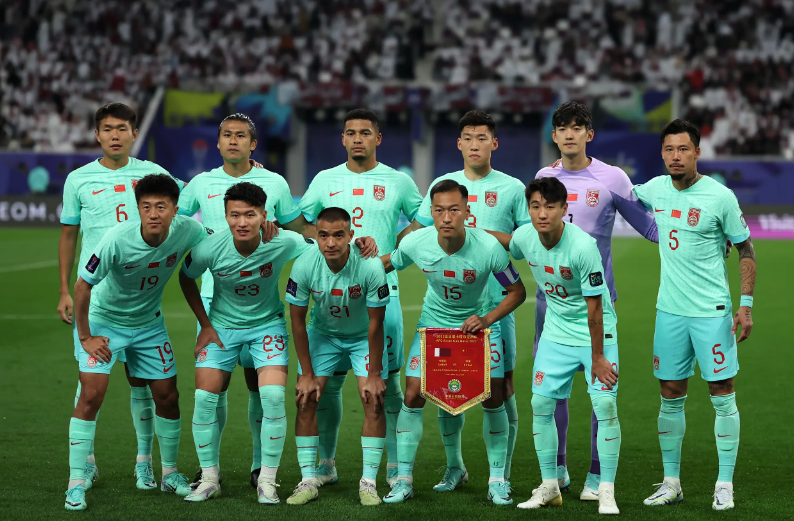 国足13次出战亚洲杯首次小组赛0进球
北京时间1月23日消息,2023亚洲杯小组
资讯
国足13次出战亚洲杯首次小组赛0进球
北京时间1月23日消息,2023亚洲杯小组
资讯
-
 大家一起关注新疆乌什7.1级地震救援见闻
看到热气腾腾的抓饭马上就要出锅、村里大家
资讯
大家一起关注新疆乌什7.1级地震救援见闻
看到热气腾腾的抓饭马上就要出锅、村里大家
资讯
-
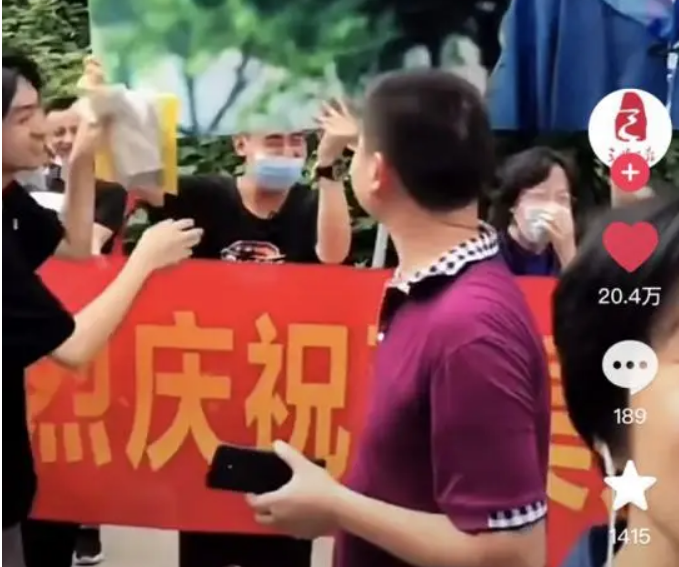 一个“江浙沪人家的孩子已经不卷学习了”的新闻引发议论纷纷
星标★
来源:桌子的生活观(ID:zzdshg)
没
资讯
一个“江浙沪人家的孩子已经不卷学习了”的新闻引发议论纷纷
星标★
来源:桌子的生活观(ID:zzdshg)
没
资讯
-
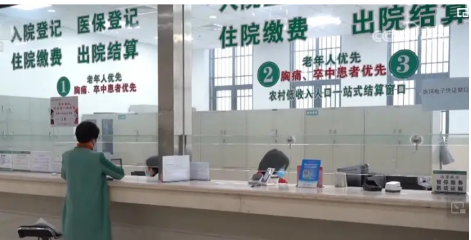 透过数据看城乡居民医保“含金量” 缴费标准是否合理?
记者从国家医保局了解到,近期,全国大部分地区
资讯
透过数据看城乡居民医保“含金量” 缴费标准是否合理?
记者从国家医保局了解到,近期,全国大部分地区
资讯
-
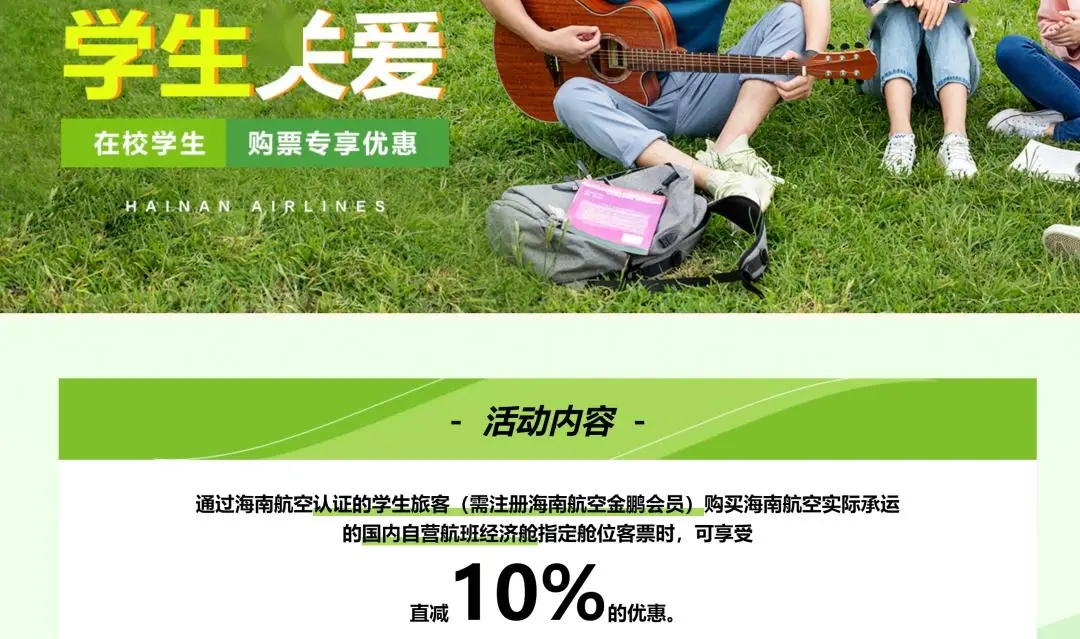 海南大学生返校机票贵 有什么好的解决办法吗?
近日,有网友在“人民网领导留言板&rdqu
资讯
海南大学生返校机票贵 有什么好的解决办法吗?
近日,有网友在“人民网领导留言板&rdqu
资讯
-
 奥运冠军刘翔更新社交账号晒出近照 时隔473天更新动态!
2月20日凌晨2点,奥运冠军刘翔更新社交账号晒
资讯
奥运冠军刘翔更新社交账号晒出近照 时隔473天更新动态!
2月20日凌晨2点,奥运冠军刘翔更新社交账号晒
资讯
-
 中国减排方案比西方更有优势
如今,人为造成的全球变暖是每个人都关注的问
资讯
中国减排方案比西方更有优势
如今,人为造成的全球变暖是每个人都关注的问
资讯
-
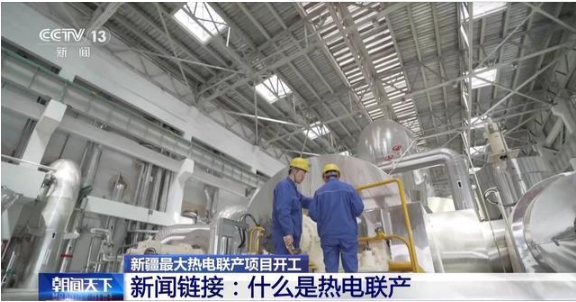 新增供热能力3200万平方米 新疆最大热电联产项目开工
昨天(26日),新疆最大的热电联产项目—&md
资讯
新增供热能力3200万平方米 新疆最大热电联产项目开工
昨天(26日),新疆最大的热电联产项目—&md
资讯
-
 王自如被强制执行3383万
据中国执行信息公开网消息,近期,王自如新增一
资讯
王自如被强制执行3383万
据中国执行信息公开网消息,近期,王自如新增一
资讯

